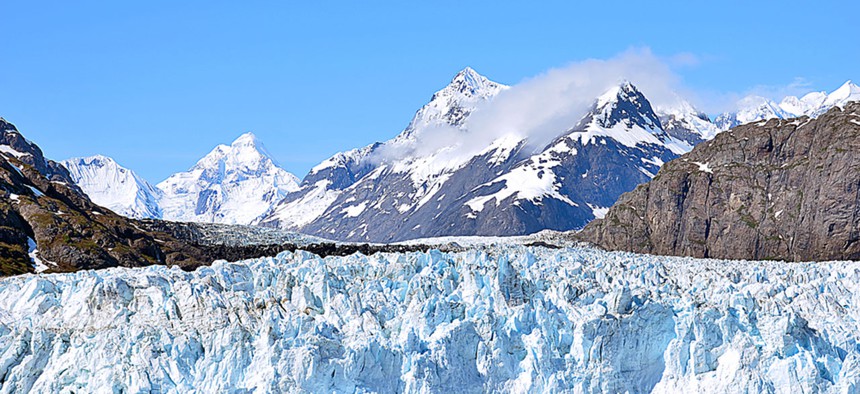
HurleySB/Shutterstock.com
Obama Embarks on Alaska Trip to Talk Climate, Glaciers
Warren G. Harding had a different kind of trip north, and didn’t live to tell the tale.
As President Obama embarks on the most ambitious presidential exploration of Alaska in U.S. history, he hopes to call attention to the threats facing that state's precious and majestic glaciers, attending a State Department-sponsored conference on glaciers and meeting with locals concerned about their melting.
That probably means he won't do what the last president to spend a lot of time in Alaska did: have the Navy bombard a glacier for his amusement. That was part of the entertainment for President Harding during his historic tour of Alaska in July 1923. With the president aboard the USS Henderson going from Juneau to Skagway, the ship's gunners fired several rounds of 5-inch shells into the wall of the Taku Glacier "so that Harding could watch the flashing ice avalanche," according to Harding's biographer, Francis Russell.
What Harding saw is called "calving," when huge chunks of ice "calv," or break off, a glacier. "It is very dramatic. I'm sure President Harding liked that," joked Michael Hawfield, an expert on Alaska history and an associate professor at the Kachemak Bay campus of Kenai Peninsula College in the University of Alaska system.
The glacier survived Harding's trip, though the president himself didn't. He died just 10 days after leaving Alaska exhausted and worn out by the exertions of the trip. Harding was the first president to visit Alaska, followed by Franklin D. Roosevelt during World War II, and nine of the 11 presidents after Alaska became a state in 1959. But most of those were refueling stops as they jetted off to Asian summits. One met a pope in the state and another met a Japanese emperor. But none had Alaska as the prime destination between Harding in 1923 and Obama, who will be in the state Monday through Wednesday.
With Air Force One and Marine One at his disposal, Obama will not face the strains and stresses that contributed to Harding's death. The president's journey will take him 8,400 miles in only three days, leaving Washington on Monday morning and returning to the White House on Thursday morning. In contrast, Harding's trip in 1923—which he called his "Voyage of Understanding"—was planned for 15,000 miles. It is unthinkable by modern standards for a president, with half his cabinet in tow, to hit the road for a three-month trip with multiple events scheduled for almost every single day. That is what Harding attempted. Alternately by train, boat, and horse, he was to go as far north as Alaska and Canada and as far south as the Panama Canal and Puerto Rico.
But he never would reach the end of the itinerary. Even before he reached Alaska, he was near-death. He had driven a wheat binder under a broiling-hot sun while wearing his suit, had given 80 speeches, had stood for hours in rainstorms, had endured severe sunburn and blistered lips, and had taken an excruciating 75-mile car ride in Utah on unpaved roads. According to his doctor, the next leg in Utah was even worse—a horseback ride on the rocky bed of the Virgin River. "The president cut a figure in leather chaps, blue flowing neckerchief, and Panama hat," wrote Dr. Joel T. Boone. But, he added, the president "suffered from hemorrhoids and with the saddle acting like a file, he could find relief from pain only by standing in the stirrups."
By the time he reached Tacoma, Harding was in trouble, finally complaining about his schedule. "Unless it is radically modified ... it will kill me," he said, adding, "I just cannot keep up such a pace without dire consequences to me." His doctors hoped Alaska would be more relaxing. But instead of taking the ordered rest, Harding insisted on staying up late every night on the ship, playing poker and bridge and shuffleboard, and watching movies on deck. Once in Alaska, things got worse. His aides had told him to wear long underwear and winter clothes. But the temperature when he got to Alaska was in the mid-90s. With stops at 10 ports, nonstop speeches—including one during heavy rain in Juneau—and seemingly endless ceremonies with native groups and politicians, Harding was exhausted.
Again, he ignored orders to rest, driving a spike to complete the Alaskan railroad, touring a coal mine, and visiting fish markets, baseball fields, and midnight banquets. Toss in some tainted crabs, a destroyer ramming his ship and tossing him out of his bed, and more speeches, and Harding was done. The White House physician had secretly brought a coffin on the trip out of fear that the ailing first lady would not survive. But it was the president who succumbed to the rigors the trip, dying in San Francisco.
Some 92 years later, Obama will not face similar rigors. He will be away from his White House bed only three nights, spending two in Anchorage and one aboard Air Force One. There will be no speeches in the rain, no midnight banquets and no tainted crab on his menu. With the temperatures in the mid-70s, he'll leave his long underwear home. He will, though, face some of the same issues that were on Harding's Alaskan agenda. Primarily, that will be the tension between development and preservation.
"We still see the same thing today," Hawfield told National Journal. "That is a longstanding tug in Alaskan society." At the time of Harding's visit, there were fears that overfishing would soon wipe out the stocks of halibut, salmon, and cod, forcing some government regulation of the industry. Again, there is concern about the fish, something that makes Obama's trip to a fishing village at Dillingham very topical.
"That is ground central for the fishing issues," Hawfield said. More so than in Harding's time, the concern is over the general health of the water, with acidification of ocean waters in the north as well as the general warming of the waters in both south and north.
Additionally, Obama's decision to be the first president to venture to the Arctic will bring him face-to-face with other environmental challenges when he goes to Kotzebue. "That is a perfect place to get a sense of the delicate nature of the Arctic as well as the struggles of the small bush communities, as they are called here," said Hawfield, who sees some of the challenges out his window. "We see right now a major die-off of sea birds where I live. We don't know why. We think maybe they are starving to death, that something is happening in the water that is causing stress."
He also can see three glaciers from his office window and he's glad that the president is coming to take stock, undeterred by the fact that Alaskan is a solidly Republican state that gave him only 38 percent of the vote in 2008 and 41 percent in 2012. "As an Alaskan, I'm just happy that he's going to take more time here than is usually the case," he said, noting that past presidents have rarely strayed far from Anchorage and the military bases where their planes were refueled. "The fact that Obama is actually going to the real Alaska is especially important."
And, it goes without saying, he is grateful that the president will not be ordering the Navy to shell any glaciers while he's there.
(Image via HurleySB/Shutterstock.com)







